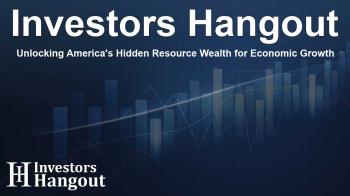Unlocking America's Hidden Resource Wealth for Economic Growth

Unlocking America's Hidden Resource Wealth
A recent presentation by Jim Rickards, a former CIA analyst and White House advisor, has drawn attention as discussions intensify around President Trump's ambitious proposal, known as the "Big Beautiful Bill". This initiative focuses on enhancing the nation's energy capacity, infrastructure advancement, and overall national strength.
As the nation gears up for significant policy moves, a critical question arises: Could the U.S. already have access to a treasure trove of resources that could fuel this transformative agenda without resorting to borrowing or monetary printing?
A Resource Most Americans Have Never Heard Of
During his talk, Rickards brought to light an often-overlooked asset in the fiscal conversation: the extensive mineral deposits lying beneath federally managed U.S. territories. These invaluable resources—which include lithium, uranium, copper, and rare earth elements—are vital for national defense and a multitude of technologies.
Rickards highlights staggering figures, revealing that an estimated $516 billion worth of minerals is located in the Salton Sea area of California, while Nome, Alaska, holds about $3.1 trillion. Furthermore, he notes that Midland, Texas could house an astounding $7.35 trillion.
The Inaccessible Trust
Rickards emphasizes a unique aspect of these resources: a financial "trust" that has effectively kept them shielded from exploitation by politicians, allowing their intrinsic value to accumulate over the decades.
Signs of a Policy Reversal
According to Rickards, a notable shift in policy is underway. President Trump has acknowledged, "There are certain areas where we have great, raw earth… and we’re not allowed to use it because of the environment. I’m going to open them up." This statement signals a proactive approach to tapping into the nation’s mineral wealth.
Rickards interprets Trump's comments as a signal that the administration is ready to prioritize the reopening of mineral-rich federal lands, expediting the processes for companies poised to extract these valuable resources.
A Revolutionary Economic Strategy
While Rickards refrains from directly linking these policy changes to the funding of the "Big Beautiful Bill," he strongly suggests that they could play a pivotal role in the administration's broader economic aspirations. This indicates a potential alignment of resources with the government's financial plans.
A Public Resource, Not a Public Giveaway
Rickards clarifies that this initiative does not resemble typical government assistance programs, such as those provided during the COVID-19 relief efforts. Instead, it's an opportunity for regular Americans to tap into newfound wealth beyond their wildest expectations.
He reassures the public that these resources are very much real, identified, and documented. "We know exactly where these minerals are. We know they’re worth trillions of dollars. And now—for the first time in half a century—we can go get them," he declares.
After Decades of Delay, a Window Opens
Emphasizing the overdue nature of these developments, Rickards recounts how long these vital resources have remained dormant: projects like Resolution Copper Mine have been stagnant for 29 years, Pebble Mine since 1990, and Thacker Pass Lithium Mine has been inactive since 1978.
He notes, "We’ve had this rich 'endowment' right under our feet… yet for years, we refused to touch it." The potential shift in policy indicates that change may be on the horizon, and he asserts that the convergence of timely leadership and resource accessibility is not a matter of chance.
About Jim Rickards
Jim Rickards is an esteemed figure with a robust background as a former advisor to the CIA, U.S. Treasury, and Pentagon. He significantly contributed to shaping the Petrodollar Accord and has provided strategic consultancy to various administrations. As a bestselling author and renowned commentator, Rickards is frequently sought after for his insightful perspectives on U.S. economic trends and global power relationships.
Frequently Asked Questions
What is Jim Rickards' main argument regarding U.S. mineral resources?
Rickards argues that the vast mineral deposits beneath federal lands represent a significant untapped resource that could support national economic initiatives without external borrowing or money printing.
How much are the mineral resources worth according to Rickards?
He estimates that the mineral resources located in specific areas like Salton Sea, Nome, and Midland collectively amount to over $10 trillion.
What changes is President Trump proposing regarding these resources?
Trump indicated plans to open up previously restricted lands for mineral extraction, signaling a shift towards utilizing these resources for national growth.
How does Rickards differentiate this initiative from previous government aid programs?
He describes it as a chance for individuals to gain wealth through the utilization of real resources, unlike temporary government stimulus checks provided during emergencies.
Why have these resources remained untapped for so long?
Rickards explains that political barriers and environmental regulations have historically prevented exploration and extraction of these valuable minerals.
About The Author
Contact Logan Wright privately here. Or send an email with ATTN: Logan Wright as the subject to contact@investorshangout.com.
About Investors Hangout
Investors Hangout is a leading online stock forum for financial discussion and learning, offering a wide range of free tools and resources. It draws in traders of all levels, who exchange market knowledge, investigate trading tactics, and keep an eye on industry developments in real time. Featuring financial articles, stock message boards, quotes, charts, company profiles, and live news updates. Through cooperative learning and a wealth of informational resources, it helps users from novices creating their first portfolios to experts honing their techniques. Join Investors Hangout today: https://investorshangout.com/
The content of this article is based on factual, publicly available information and does not represent legal, financial, or investment advice. Investors Hangout does not offer financial advice, and the author is not a licensed financial advisor. Consult a qualified advisor before making any financial or investment decisions based on this article. This article should not be considered advice to purchase, sell, or hold any securities or other investments. If any of the material provided here is inaccurate, please contact us for corrections.

